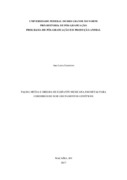Please use this identifier to cite or link to this item:
https://repositorio.ufrn.br/handle/123456789/24289| Title: | Palma miúda e orelha de elefante mexicana em dietas para cordeiros de dois grupamentos genéticos |
| Other Titles: | Nopalea cochenillifera and opuntia stricta in diets for lambs of two genetic groups |
| Authors: | Guerreiro, Ana Luiza |
| Advisor: | Aguiar, Emerson Moreira de |
| Keywords: | Comportamento ingestivo;Digestibilidade aparente;Mestiços;Semiárido;Soinga |
| Issue Date: | 26-Apr-2017 |
| Citation: | GUERREIRO, Ana Luiza. Palma miúda e orelha de elefante mexicana em dietas para cordeiros de dois grupamentos genéticos. 2017. 41f. Dissertação (Mestrado em Produção Animal) - Universidade Federal do Rio Grande do Norte, Universidade Federal do Rio Grande do Norte, Natal, 2017. |
| Portuguese Abstract: | Objetivou-se avaliar o consumo e digestibilidade aparente da matéria seca e nutrientes, o comportamento ingestivo e o desempenho de ovinos de dois grupamentos genéticos (Soinga e ½ Santa Inês x ½ Soinga) alimentados com genótipos de palma forrageira resistentes à cochonilla do carmim (Miúda e Orelha de Elefante Mexicana). Foram utilizados 28 ovinos, sendo 14 Soingas e 14 ½ Santa Inês x ½ Soinga com peso médio inicial de 17,4 ± 1,58 kg, distribuídos aleatoriamente em delineamento inteiramente casualizado em esquema fatorial 2x2. Os animais permaneceram confinados por 102 dias, sendo os 30 primeiros para adaptação dos animais às instalações e manejo experimental, os 72 dias restantes destinados à coleta de dados e amostras. Não houve interação significativa entre espécies de palma e grupamentos genéticos para o consumo de matéria seca e nutrientes. A ingestão de MS, MO, MOD, PB, FDN, CNF e NDT em kg/dia não foi afetada pelas dietas experimentais (1,009; 0,910; 0,686; 0,139; 0,298; 0,557 e 0,732, respectivamente). O consumo de matéria seca e nutrientes e a conversão alimentar não foram diferentes entre os grupamentos genéticos. Os coeficientes da digestibilidade da MS, MO, PB e CNF foram maiores quando os animais consumiam a palma Orelha de Elefante Mexicana, não houve interação entre as espécies de palma e os grupamentos genéticos estudados para a digestibilidade aparente dos nutrientes. Não houve interação entre as espécies de palma e os grupamentos genéticos para as variáveis comportamentais estudadas. Não foram verificados efeitos das palmas, grupamentos genéticos e interação entre ambos para o ganho de peso médio diário, que apresentou média de 0,133 kg/dia. A digestibilidade da palma Orelha de Elefante Mexicana apresentou superioridade à palma miúda. Os grupamentos genéticos Soinga e ½ Santa Inês x ½ Soinga apresentaram desempenho semelhantes quando alimentados com as diferentes espécies de palma, podendo a palma Miúda e Orelha de Elefante Mexicana ser utilizadas na dieta para cordeiros em confinamento. |
| Abstract: | The objective of this study was to evaluate the intake and apparent digestibility of the dry matter and nutrients, the ingestive behavior and the performance of sheep of two genetic groups (Soinga and ½ Santa Inês x ½ Soinga) fed with forage palm genotypes resistant to Cochineal carmine (Miúda and Mexican Elephant Ear). Twenty - eight sheep were used, 14 Soingas and 14 ½ Santa Inês x ½ Soinga with initial mean weight of 17.4 ± 1.58 kg, randomly distributed in a completely randomized design in a 2x2 factorial design. The study lasted 102 days, with the first 30 days for adaptation of the animals to the facilities, diet and routine management, and 72 days of observation and collection for performance evaluation. There was no significant interaction between cactus species and genetic groups for the consumption of dry matter and nutrients. Ingestion of DM, OM, OMD, CP, NDF, CNF and TDN by dietary components in kg/day was not affected by experimental diets (1.009, 0.910, 0.666, 0.139, 0.298, 0.557 and 0.732, respectively). The intake of dry matter and nutrients and feed conversion were not different between the genetic groups. The total digestibility of DM, OM, CP and NFC was higher when the animals consumed the Mexican Elephant Ear cactus, there was no interaction for nutrients digestibility between the cactus species and the genetic groups. There was no interaction between the cactus species and the genetic groups for the behavioral variables studied. There was no interaction between the studied cactus species and the genetic groups for the average daily weight gain, 0.133 kg/day. The digestibility of the Mexican Elephant Ear was higher than Miúda. The genetic groups Soinga and ½ Santa Inês x ½ Soinga had similar performance when fed with the different cactus species, and the Nopalea cochenillifera and the Opuntia stricta can be used in the diet for lambs in confinement. |
| URI: | https://repositorio.ufrn.br/jspui/handle/123456789/24289 |
| Appears in Collections: | PPGPA - Mestrado em Produção Animal |
Files in This Item:
| File | Description | Size | Format | |
|---|---|---|---|---|
| AnaLuizaGuerreiro_DISSERT.pdf | 684,13 kB | Adobe PDF |  View/Open |
Items in DSpace are protected by copyright, with all rights reserved, unless otherwise indicated.

